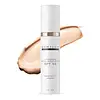What's inside
What's inside
 Key Ingredients
Key Ingredients

 Benefits
Benefits

 Concerns
Concerns

 Ingredients Side-by-side
Ingredients Side-by-side

Zinc Oxide 12%
Cosmetic ColorantEthylhexyl Methoxycinnamate 7.5%
UV AbsorberWater
Skin ConditioningCyclopentasiloxane
EmollientNiacinamide
SmoothingOleth-3 Phosphate
Octyldodecyl Neopentanoate
EmollientHydroxyethyl Acrylate/Sodium Acryloyldimethyl Taurate Copolymer
Emulsion StabilisingGlycerin
HumectantPolygonum Aviculare Extract
EmollientSodium Hyaluronate
HumectantTocopheryl Acetate
AntioxidantEthylhexylglycerin
Skin ConditioningTriethoxysilylethyl Polydimethylsiloxyethyl Hexyl Dimethicone
Skin ConditioningPolyglyceryl-3 Polydimethylsiloxyethyl Dimethicone
Skin ConditioningPEG-7 Trimethylolpropane Coconut Ether
EmulsifyingPolyisobutene
Triethoxycaprylylsilane
Disodium EDTA
Iron Oxides
Phenoxyethanol
PreservativeZinc Oxide 12%, Ethylhexyl Methoxycinnamate 7.5%, Water, Cyclopentasiloxane, Niacinamide, Oleth-3 Phosphate, Octyldodecyl Neopentanoate, Hydroxyethyl Acrylate/Sodium Acryloyldimethyl Taurate Copolymer, Glycerin, Polygonum Aviculare Extract, Sodium Hyaluronate, Tocopheryl Acetate, Ethylhexylglycerin, Triethoxysilylethyl Polydimethylsiloxyethyl Hexyl Dimethicone, Polyglyceryl-3 Polydimethylsiloxyethyl Dimethicone, PEG-7 Trimethylolpropane Coconut Ether, Polyisobutene, Triethoxycaprylylsilane, Disodium EDTA, Iron Oxides, Phenoxyethanol
Butyl Methoxydibenzoylmethane 3%
UV AbsorberHomosalate 15%
Skin ConditioningEthylhexyl Salicylate 5%
UV AbsorberOctocrylene 10%
UV AbsorberWater
Skin ConditioningPolymethylsilsesquioxane
Glycerin
HumectantDimethicone
EmollientPoly C10-30 Alkyl Acrylate
Emulsion StabilisingStyrene/Acrylates Copolymer
Silica
AbrasiveCaprylyl Methicone
Skin ConditioningAcrylates/Dimethicone Copolymer
Skin ConditioningDiethylhexyl Syringylidenemalonate
Skin ProtectingPEG-100 Stearate
Glyceryl Stearate
EmollientPhenoxyethanol
PreservativePotassium Cetyl Phosphate
EmulsifyingTocopherol
AntioxidantCaprylyl Glycol
EmollientPanthenol
Skin ConditioningAcrylates/C10-30 Alkyl Acrylate Crosspolymer
Emulsion StabilisingTriethanolamine
BufferingPEG-8 Laurate
EmulsifyingInulin Lauryl Carbamate
Emulsion StabilisingChlorphenesin
AntimicrobialP-Anisic Acid
MaskingCaprylic/Capric Triglyceride
MaskingXanthan Gum
EmulsifyingDisodium EDTA
Cassia Alata Leaf Extract
AstringentMaltodextrin
AbsorbentSodium Dodecylbenzenesulfonate
CleansingButyl Methoxydibenzoylmethane 3%, Homosalate 15%, Ethylhexyl Salicylate 5%, Octocrylene 10%, Water, Polymethylsilsesquioxane, Glycerin, Dimethicone, Poly C10-30 Alkyl Acrylate, Styrene/Acrylates Copolymer, Silica, Caprylyl Methicone, Acrylates/Dimethicone Copolymer, Diethylhexyl Syringylidenemalonate, PEG-100 Stearate, Glyceryl Stearate, Phenoxyethanol, Potassium Cetyl Phosphate, Tocopherol, Caprylyl Glycol, Panthenol, Acrylates/C10-30 Alkyl Acrylate Crosspolymer, Triethanolamine, PEG-8 Laurate, Inulin Lauryl Carbamate, Chlorphenesin, P-Anisic Acid, Caprylic/Capric Triglyceride, Xanthan Gum, Disodium EDTA, Cassia Alata Leaf Extract, Maltodextrin, Sodium Dodecylbenzenesulfonate
 Reviews
Reviews

Ingredients Explained
These ingredients are found in both products.
Ingredients higher up in an ingredient list are typically present in a larger amount.
Disodium EDTA plays a role in making products more stable by aiding other preservatives.
It is a chelating agent, meaning it neutralizes metal ions that may be found in a product.
Disodium EDTA is a salt of edetic acid and is found to be safe in cosmetic ingredients.
Learn more about Disodium EDTAGlycerin is already naturally found in your skin. It helps moisturize and protect your skin.
A study from 2016 found glycerin to be more effective as a humectant than AHAs and hyaluronic acid.
As a humectant, it helps the skin stay hydrated by pulling moisture to your skin. The low molecular weight of glycerin allows it to pull moisture into the deeper layers of your skin.
Hydrated skin improves your skin barrier; Your skin barrier helps protect against irritants and bacteria.
Glycerin has also been found to have antimicrobial and antiviral properties. Due to these properties, glycerin is often used in wound and burn treatments.
In cosmetics, glycerin is usually derived from plants such as soybean or palm. However, it can also be sourced from animals, such as tallow or animal fat.
This ingredient is organic, colorless, odorless, and non-toxic.
Glycerin is the name for this ingredient in American English. British English uses Glycerol/Glycerine.
Learn more about GlycerinPhenoxyethanol is a preservative that has germicide, antimicrobial, and aromatic properties. Studies show that phenoxyethanol can prevent microbial growth. By itself, it has a scent that is similar to that of a rose.
It's often used in formulations along with Caprylyl Glycol to preserve the shelf life of products.
Water. It's the most common cosmetic ingredient of all. You'll usually see it at the top of ingredient lists, meaning that it makes up the largest part of the product.
So why is it so popular? Water most often acts as a solvent - this means that it helps dissolve other ingredients into the formulation.
You'll also recognize water as that liquid we all need to stay alive. If you see this, drink a glass of water. Stay hydrated!
Learn more about Water